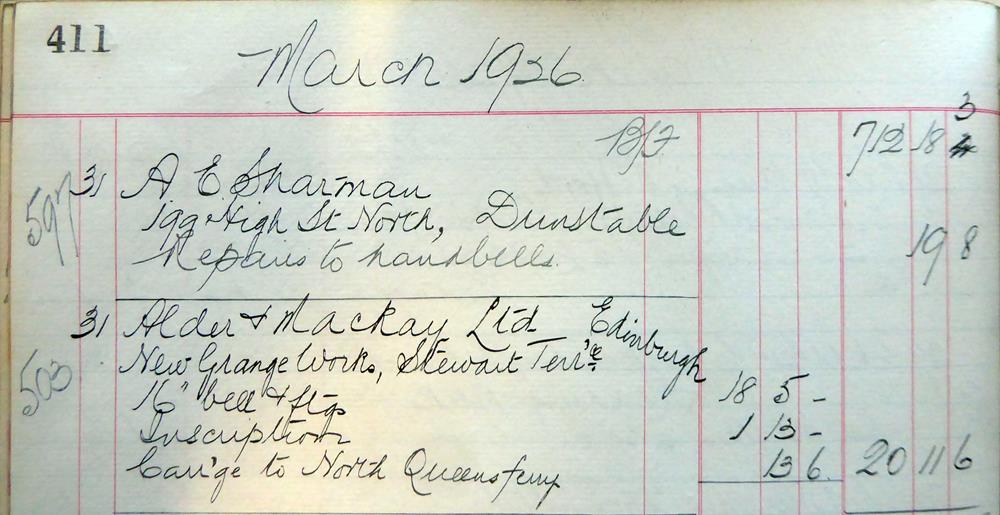Church
North Queensferry Church History
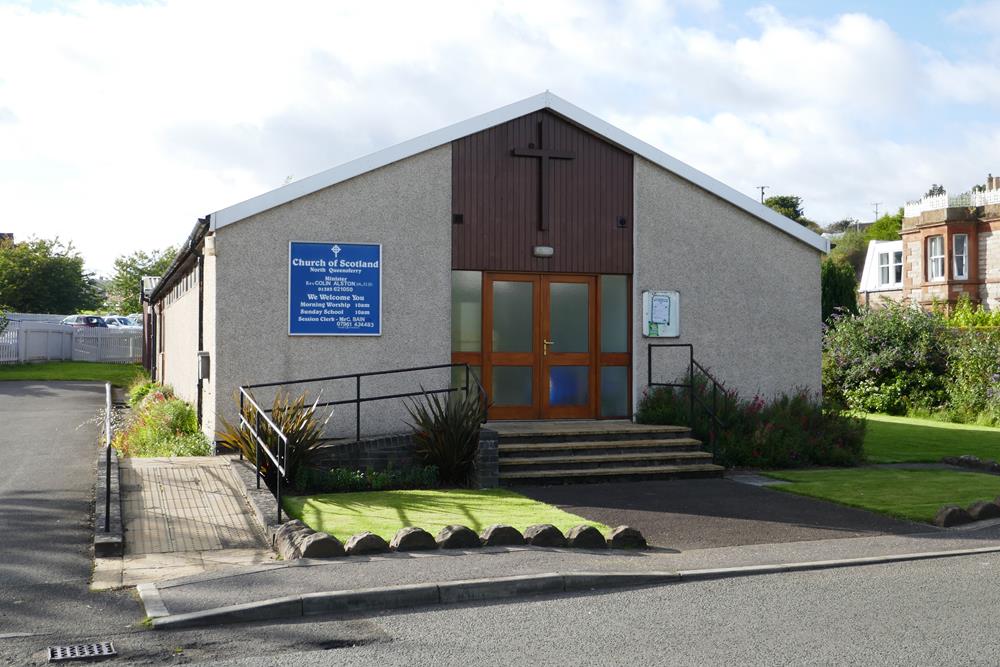
The present church building, next to the Railway Station and dating to 1964 is arguably the fourth in the village.
The first church was St James’s Chapel, which was built some time prior to 1300, eventually ceasing to function as a chapel some time in the late 1500s. The interior of the ruined building later became a cemetery.
For the next three centuries, until the 1850s, villagers would have travelled to the churches in Inverkeithing or in South Queensferry across the water.
In 1642, with the assent of Dunfermline parish, North Queensferry became attached to the Inverkeithing parish church; (North Queensferry remained part of the official parish of Dunfermline until 1855, when it formally transferred to Inverkeithing.)
The sailors of North Queensferry had a loft or gallery in St Peter’s Church Inverkeithing, on the south side of the west end of the church, where they might sit together for worship.
top of page
Field Conventicles (open-air services)
In 1662, the restoration of Charles II ended the years of Cromwellian dictatorship, but brought further difficulties for the Church. Charles attempted to bind the spiritual power of the church to the secular power of the state by appointing bishops to act as overseers to the church ministers. Ministers were obliged to accede to the power of a bishop or to lose their living. 270 Presbyterian ministers refused to accede to episcopal power and were expelled from their parishes. Many of these continued to carry out open-air services or field conventicles; one was held close to North Queensferry in 1678.
James Henderson, an innkeeper in North Queensferry was declared a rebel, and had his goods forfeited in 1677 for attending a conventicle. In 1678, Robert Dick, a ferry man, was one of a number charged with “withdrawing from the church and keeping house and field conventicles and for disorderly marriages and baptisms.” He was charged again with similar offences in 1682.
The rebellious spirit and distance from a church left villagers somewhat remote from the official religious authorities. In 1695 the people of the North Ferry were admonished publicly by the minister “not to cross the passage in boats on the Sabbath Day and not to carry in their water as formerly.” The Inverkeithing Kirk session records similar entries in 1697 and 1736.
The Sailors’ Society
In the 18th century, The Sailors’ Society was formed as a type of friendly society, who aimed to provide for the decent burial of deceased members and certain non-members, who were charged a fee for a burial plot. The burial ground was in the ruins of St James’ chapel. They built the wall round the cemetery in 1752. Precisely why the wall was built is not known; it may have been as protection against grave-robbers, or as a retaining wall for earth as the ground level rose inside the cemetery.
The society was dissolved some time in the late 18th century, and then reconstituted in October 1818. The former members adopted the existing rules of the original society. Members paid an entry fee, which covered the eventual cost of their burial, contributed to the upkeep of the graveyard, and contributed to a form of social security. Some burials were provided gratis to non-members, and on occasion loans were provided to repair wells, support the needy and fend off starvation.
top of page
19th Century – Reports from The Dunfermline Press.
This local newspaper was first issued on 21st April 1859. It was founded by the local linen merchant, Erskine Beveridge, who was Provost of Dunfermline for the year 1853.
The newspaper articles are a valuable archive of information about local affairs in North Queensferry.
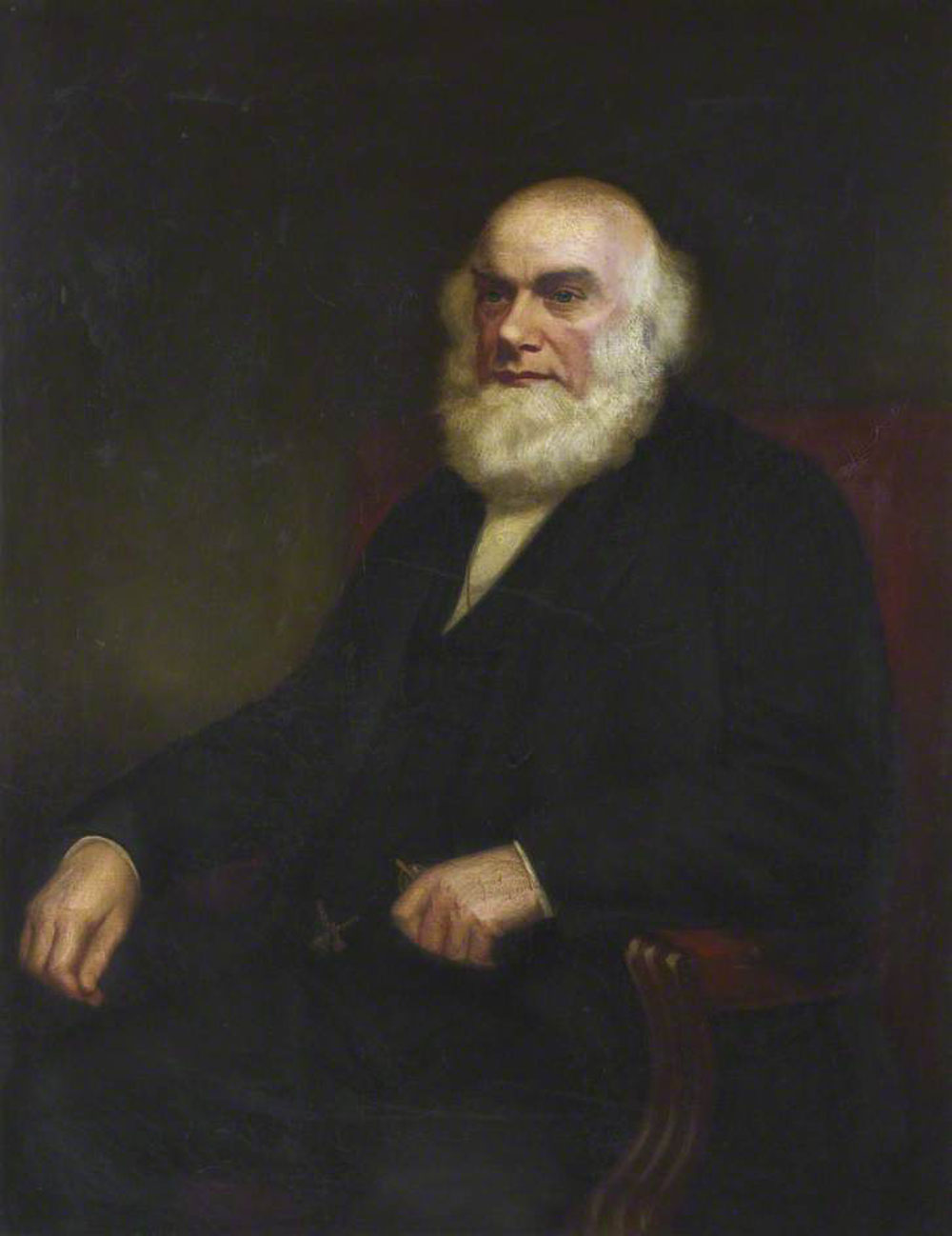
Robert Robertson succeeded Erskine Beveridge as Provost of Dunfermline, from 1854 to 1860.
He was also a linen merchant; living in Dean Cottage, North Queensferry. The 1861 census lists him as age 59 “Master Linen and Woollen Draper – employs 3 men & 8 boys” born in 1802 in Kinross; living with his wife Susan ( age 52 born 1809 in Dunfermline) sons George (25 born 1836 in Dunfermline) and Robert (age 12 born 1849 in Dunfermline) and a servant Hanna Whyte (age 21 born 1840 in Crossgates.)
His portrait hangs in Pittencrieff House in Dunfermline.
Robertson took an active interest in the welfare of the village, along with his neighbours, Col. and Mrs Elder of St Margaret’s, Mrs Douglas (widow of a deceased banker) of Craigdhu, and John Anderson, the local school teacher.
top of page
The Meeting House
In 1855, Robertson purchased a former inn, and founded a “Meeting House” for the village. Over the following years this was known as the Meeting House, Preaching Station and finally the Mission Hall.
From the Dunfermline Press Thursday Aug 11 1859: “There is only one place of worship in the village. As yet no special edifice has been constructed for this purpose, the present meeting-house, indeed, having formerly answered the purpose of an inn. The church here is un-denominational. Preaching is very ably supplied by Mr Howat, who, we may be allowed to judge, is quite a favourite with his by no means indiscriminating charge. This preaching station is under the patronage and support of Provost Robertson. Before he provided this accommodation, the people were under the necessity of crossing the ferry, and going to Inverkeithing every Sunday for public worship. Now, however, while the meeting place affords seating for a congregation of about 200, scarcely one individual prefers going to other side, and few seek to go to the church in Inverkeithing. A Sabbath school is held in the school-room, and is taught by a few young persons in the place.”
Where was the Meeting House?
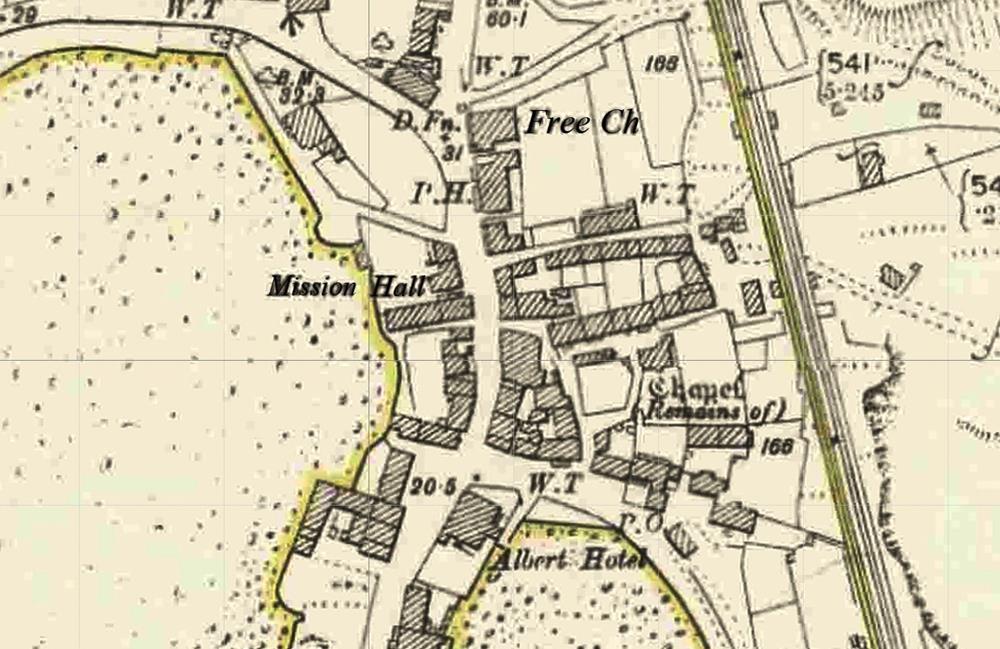
This 1896 OS map shows the Mission Hall, but is tantalizingly vague about which building is intended.
Is it the building to the right of the word “Hall”
– 4 Main Street, the current site of Rankin’s Café?
Or is it the building immediately beneath the “ll”in Hall
– 14 Main Street – Davidson’s buildings?
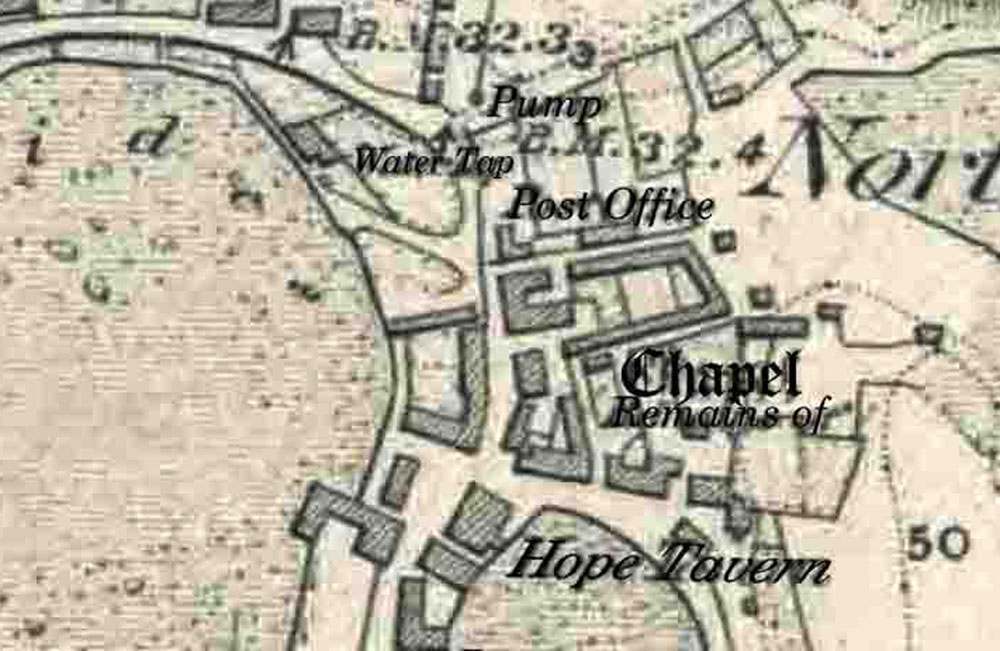
The building at 4 Main Street is not shown in the 1855 OS map, lending weight to the location being in Davidson’s Buildings.
(Further research into title deeds might determine the exact building.)
Inns and Temperance
The article cited above states that the Meeting House was formerly an inn, but this does not mean that it was, or was owned, by either the Albert Hotel (Hope Tavern in 1855) or the Ferry Bridge (Roxburgh Arms).
The New Statistical Account of Scotland, 1845, includes the following entry concerning Inns in the parish of Inverkeithing.
“lncluding the back shops of grocers, there are 23 houses in the burgh where spirits may be bought in small quantities, and drunk upon the premises. Two of them only are inns for the reception and entertainment of travellers. In the North Ferry, there are 13 such places, including the great inn, and a secondary one . . . ; but some of these are required to accommodate passengers at North Ferry, and travellers upon the public road from Edinburgh to Perth and lnverness.” [The population of the village was about 450 in the 1840s.]
Not everyone was enamoured with the ready availability of alcohol, and a Temperance Society, or Total Abstinence Society was established in the 1850s
The Dunfermline Press of June 1859 reports:
Temperance Pleasure Excursion.
“On Monday, the members of the Total Abstinence Society. North Queensferry, enjoyed their first excursion trip. The place chose was Stirling, whither upwards of 120 of them were conveyed in the good steam-ship “Venture” at an early hour in the morning. [they arrived in Stirling at 7:30 am!] We have said that the above excursion was under the auspices of the Temperance Society of North Queensferry, and we may add that, in the annals of the village, we can find no trace of a predecessor; in fact, until the committee of the Society, with commendable energy, and most untiring zeal, took the matter up, the thing was altogether unknown.”
The new Temperance Society was chaired by Provost Robert Robertson; they held weekly meetings in the Meeting hall.
Dunfermline Press: Thu Jun 30 1859
The usual weekly meeting of the Temperance Society. Provost Robertson in the Chair.
James Anderson – teacher – gave a reading on the Social Condition in Scotland in the Twelfth Century.
Mr H T Howat – divinity student – gave a reading of his Temperance tract entitled “The Curse of the Village.”
top of page
Ministers for the Meeting House
Mr H T Howat was one of the stream of preachers who Provost Robertson procured and paid to take Sunday Services in the Meeting House. He preached until November 1860, when he was ordained as a minister in the United Presbyterian church in Broughty Ferry.
He was followed by Mr Conner, Mr Welsh and Mr Smith, who each preached for about a year – Smith departing in April 1863.
Thereafter, ministers from Inverkeithing took regular services on a Sunday evening – Rev James McKay, Rev McGregor, Rev Andrew Brydie, Rev Robert Kay, Mr Sutherland and Rev John M Allen.
From 1860 onwards, these preachers were augmented by missionaries from the Scottish Coastal Mission; in particular Mr Hughson, who frequently took services in the Mission Hall.
Scottish Coastal Mission
While the spiritual needs of in-shore sailors and fishermen could be handled by the local church in their home port, long-distance sailors and off-shore fishermen often spent long periods at sea, out of touch with any minister. In the 19th century a number of societies began to focus on the needs of sailors and sea-going communities. Some organizations delivered bibles and tracts to visiting ships, others provided prayer meetings on ships when in port, while others provided floating churches, with ministers visiting ships at sea. These included the Scottish Coastal Mission, founded in 1850. By 1861 the Scottish Coastal Missions employed ten missionaries, serving twenty-nine stations between Cockenzie and Arbroath. Its missionaries visited sailors as well as fishermen and their families.
The Dunfermline Press of 23th August 1860, contains a report on the success of Mr Hughson an SCM missionary in Inverkething. Here are some extracts:
When Mr Hughson first came here, [two years previously in 1858] many people asked – “What is the use of a missionary here? We have two ministers already.” He admitted that they had two very good ministers, but their time was too occupied to allow them to visit the ships that came into the harbour, or indeed to visit the seafaring community at all.
Mr Hughson then gave a report of his proceedings during the time that he had been a missionary in Inverkeithing. During the past year he had held 182 meetings, some of them in the church, and others in private homes, in the open air, or on board ships. The sailors had listened to the word of salvation with great attention, and he trusted that the work begun so auspiciously would continue to spread. He had visited 2000 families during the year, and he also paid 318 visits to sick or dying persons. He had also sold 54 copies of the Scriptures to seamen, both English and foreign. This was not so large a number as he had sold last year; but this was to be accounted for by the fact that many of the seamen had been supplied with him by copies the year before. He had paid 365 visits to the ships, and distributed upwards of 500 tracts among the men. He also had nine copies of the “British Messenger” and 48 of the “Mothers’ Magazine” in circulation every month.
top of page
Other activities in the Meeting House
In August 1859, Mr Howat inaugurated a Village Reading Room. He gave a lecture on “Newspapers and the place they hold in the literature of this country.” He first traced the history of papermaking from the ancient papyrus down to the materials at present employed in the manufacture; then gave a variety of details relative to newspapers proper, with special allusion to the Times of London and other journals.
Public Lectures.
As well as Sunday services and weekly Temperance Society meetings, the Meeting House was also used a village hall, where lectures were organized on a wide range of topics, by Mr (latterly Col.) Elder of St Margaret’s House who paid for the lecturers.
Some lecturers and topics were:
November 1859, Mr Turnbull, on “Health, happiness, and home”
November 1859, Mr Howat on “A run through the colonies, with brief glances at the settlers.” In the course of his lecture, Mr Howat transported his audience to Canada, the United States, Australia, and New Zealand, and gave a variety of interesting sketches of the manners, customs, past history, and social conditions of the people.
December 1859, Mr Howat on “The Lights and Shades of our great cities.” He commenced by showing how one half of the world did not know how the other half lived; exhibiting on one hand “The Shades – some of the saddest spectacles of depraved humanity. “The Lights” he treated in a religious point of view, such as the church, schools, and missionary labours.
December 1859, Mr John Anderson, teacher, “The Food we Eat.” The adulteration our food is now subjected to, and the mode of doing it, almost defying detection by the most scrutinising process.
December 1859, Mr Forsyth of Edinburgh, on “Physiology” which he illustrated by diagrams dwelling principally on the digestive organs.
December 1859, Mr Howat on “Scotland in the Olden Times,” illustrated by diagrams, contrasting the past with the present, more especially in a religious aspect.
January 1860, Mr Alexander McAnsh on “The Magnitude of Bodies” comparing great “bodies” with small, from animalculae invisible to the naked eye , to the mighty suns and systems careering through space.
May 1860, Mr A. McAnsh on “China”
October 1860, Thomas Elder (of St Margarets House) on “Algiers.” A historical account of its rise, and then the many vicissitudes it had undergone under the French Government. He then detailed the narrative of his own residence in that country.
October 1860, Thomas Elder on “Morocco.”
November 1860, Thomas Elder on “Palestine.” Mr Elder described what he had seen. The lectures were illustrated by diagrams of ancient and modern Jerusalem, and by relics of the past glory of Palestine, such a stones from the wall of Solomon’s temple, flowers from the garden of Gethsemane and a dagger procured at Damascus. Mr Elder also exhibited a quantity of water taken from the Dead Sea – which was freely offered for anyone to taste.
November 1860, Thomas Elder gave two lectures on “America” based on his travels there. He gave, a description of the country, mode of life, and general character of the Americans. He then detailed his own observation regarding the slave trade, denouncing slavery to be against all human sympathy, and a great barrier in the way of civilization
December 1860, Rev. J.D. Fleming, Inverkeithing, on “The Natural History of Man”
January 1861, Dr Bartholomew on “ Food,” which was highly interesting, and gave great satisfaction, except to our temperance friends, who did not relish the Doctor’s remarks when he spoke of the alcohol as being an efficient food in many circumstances.
February 1861, instead of our usual lecture, we were favoured with “Readings interspersed with Music,” by Mr A. Thomson, of the Commercial Academy, Dunfermline. In the course of the parts, Mr Anderson, [local school teacher] sang several songs.
February 1861, Rev. James McKay on “China.” a very graphic sketch of the celestial empire – the dispositions and general character of the people – the absurd notions they entertain of being as they were in the past, counting all those enemies who introduced anything modern.
February 1861, Mr W. Allan of the Scottish Temperance League, on “Woman, and her Influence”
February 1861, Mr C, Connor, student of divinity, on “The Earth’s Crust.” The Meeting-house was decorated with diagrams illustrative of the lecture. Mr Connor covered Geology, from our earth’s surface to its foundations, and its relation to Him who created all.
February 1861, Mr A. L. Dick, Edinburgh, on “Nineveh.” The lecture on the former glory of that ancient city, was illustrated with large diagrams.
March 1861, Mr A. Murphy, Edinburgh, on “The Existence of the Deity.”
March 1861, Mr W., Pringle, Barns, on “Astronomy” illustrated by twelve large diagrams, comprising the solar system – sun, moon, planets, comets, the moons of Jupiter, rings of Saturn etc.
March 1861, Mr Alex. Macansh, Dunfermline, on “Knox and the Reformation.” The lecturer seemed perfectly conversant with the life and times of the great reformer.
February 1863, Mr Foullis of Fordell, on “Man’s First Abode, and how it was Prepared.”
February 1863, Mr Smith on “The Sea.”
1864 – Young Men’s Mutual Improvement Society
March 1864, Mr Bourhill, student of divinity, Inverkeithing, delivered a lecture in the Meeting-house, under the auspices of the Young Men’s Mutual Improvement Society, which was formed here some time ago. The object of the lecture was a very laudable one – viz., for promoting the pecuniary support of the Society, and the intellectual improvement of the inhabitants. Mr Bourhill chose for his subject. “Stray Thoughts on Education.”
top of page
1865 – An Open Air Sermon
In a throwback to the field canticles of the seventeenth century, The Dunfermline Press of Saturday Jun 24 1865 carried the following article:
OPEN AIR SERMON. – We note with much pleasure the interesting discourse at the Battery last Sabbath, by the Rev. E. B. Hill, of, Lochmaben. Were it possible for others to give us a discourse occasionally, weather permitting, it would be highly esteemed, and be the means of doing a great amount of good.
1871 – Biblical Association
October 1871. The annual meeting of the Biblical Association was held in the Burgh School, North Queensferry, on Friday evening last – the Rev. David Williamson, president of the association, in the chair. It appears that during the past year, 40 meetings of the association have been held. At these meetings there have been 20 conversations on passages of scriptures, and 15 original essays read by members. During the year, 70 members have been enrolled, and at the last meeting, 49 members were on the roll. The meeting was also addressed by the Rev. R. H. Muir, Dalmeny; Mr John Lumsden, Queensferry; Mr George Anderson, manager, Dalmeny Oil Works; and Mr James Cooper, Dundas Paragon Works. It is also gratifying to learn that a similar association has been formed at Dalmeny.
top of page
1876 – Looking to the future, and a proper church
By 1876, the construction of a railway line to North Queensferry was underway (the old line to the Railway Pier) and plans for the Forth Bridge were afoot. This was expected to improve the status of the village.
Dunfermline Press Saturday Jan 01 1876, Soiree and presentation at North Queensferry
Last Tuesday, a soiree was held in the Mission Hall to mark the departure of the Rev. Robert Kay who has laboured here during the last eight months as a missionary, in connection with the Free Church.
After tea, Colonel Elder gave a very interesting and favourable account of the present state of things at the Ferry and spoke encouragingly of the future. He remarked that things looked as if, at no distant date the Ferry would be made a burgh, with Provost, Baillies, etc, etc. He hoped that in a very short time, they would have a new and larger hall for their meetings, with a library and reading-room attached.
The Rev Mr Schiach, of Dunfermline, then addressed the meeting, expressing the sympathy which he and his Presbytery had with the works of the Mission from its commencement, and the deep interest they continued to take in it. He assured them that the Free Presbytery of Dunfermline would continue to support the station, and do what they could to get it made into a regular charge as soon as possible.
He looked to the Ferry as likely to become, at no distant date, the eye of the Modern Athens – the main outlet to the North, when the railway which is now in the course of construction is completed, and the Forth Bridge an accomplished fact. The Ferry must have its church as well as its Provost and Bailies.
1878 – The new Free Church
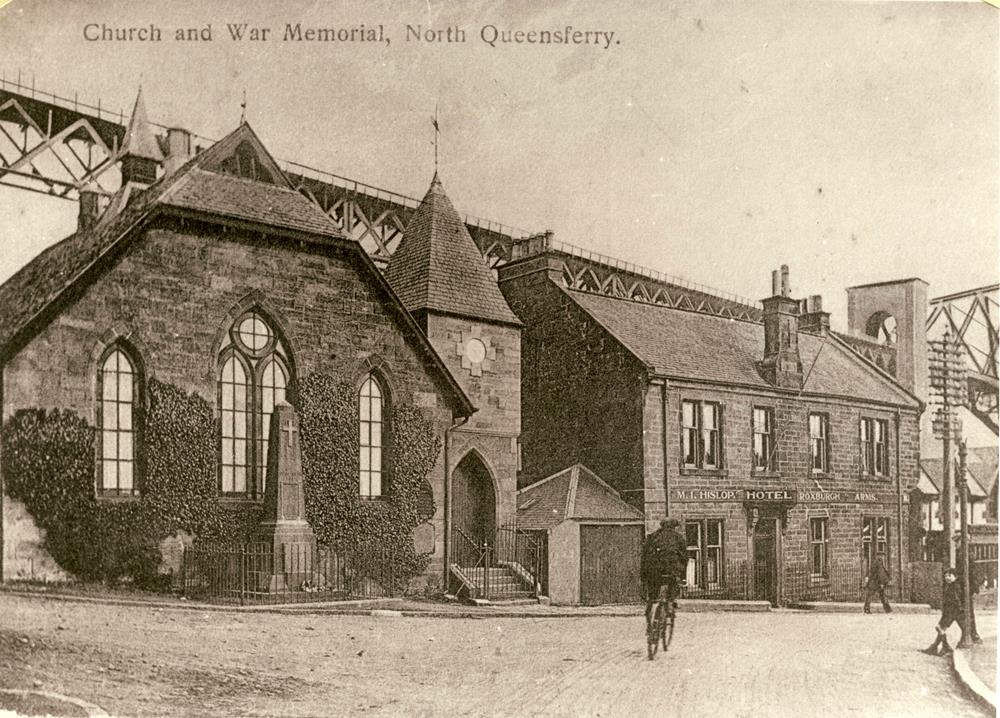
Dunfermline Press – Saturday July 13 1878.
Opening of the new Free Church at North Queensferry.
Saturday July 20 1878 – Opening of the new Free Church at North Queensferry.
The want of a place of worship has long been felt in Queensferry, and to those who had the wish to be regular attenders on the services of the sanctuary, the want was deeply felt. Inverkeithing, where the nearest place of worship is, is two miles from it, and on any stormy or wet day, to go that distance to church was out of the question.
How long this state of things would have continued it is not for us to say; but we believe that the late Provost Robertson was the first to try to amend matters, by providing a place where religious services could be held. After his death, the matter was taken up by the Rev. Mr Brydie, late of St Andrew’s Free Church, who did his utmost to establish a place of worship in the village, but he was called away to another sphere of labour before it was accomplished. With the addition of the railway to the village, and being in close proximity to Dunfermline, it was thought that many would take advantage of Queensferry as a summer resort, and the Free Church Presbytery of Dunfermline then took up the matter of providing religious ordinances for the people, and a committee was formed for that purpose.
The Hall in connection with the Hotel was secured, and the Rev. J. M. Allan, late of Canada, was engaged to labour in the district; and he has done so with such success as to obtain a grant from the Home Mission Fund for its constitution as a Mission Church.
A scheme was then organized for the erection of a church and hall by the Rev. Mr Shiach, of the Free Abbey, Dunfermline – which project, however, fell through and was abandoned. A number of influential persons, however, took an interest in the matter, and a fund was raised by voluntary subscriptions – among the subscribers to which was Mr Elder of St Margaret’s, who, in addition to presenting the Presbytery Committee with the site of the Church, gave the handsome donation of £100. His brother followed with a similar sum. Mr Sivright of the Cliff, gave £30; and Mrs Douglas, Craigdhu; Mr Henderson, Fordell; and Mr Newton, of Castlandhill, subscribed £25 each. These sums, along with a number of smaller gifts, raised the building fund up to between £400 and £500.
The amount of interest thus manifested in the scheme made the Presbyterial Committee feel justified in setting “the ball a-rolling;” and Mr Scobie, architect, was communicated with, who prepared plans for the erection of the Church, which were approved of, and the building was thereafter commenced, and, after a lapse of fully three months, has been erected.
The Church, which in every way harmonises with the locality in which it is located, is in design a simple adaptation of the Gothic style of architecture, and is situated at the entrance to the village on a commanding site overlooking the sea. The front elevation presents a gable with a central mullioned window, having the lights finished with elliptical beads mitred into a circular frame. On either side of the window a smaller light is placed, corresponding in style with the principal aperture. The entrance door, which, along with the minister’s room, is situated to the right of the front of the building, is surmounted by an elliptical head, and the whole front is finished in fine-dressed freestone. The windows throughout the design are finished with freestone dressings, while the walls have been built with whin rubble. The north and south elevations are lighted by single windows with cusped lintels. The roof is highly pitched, and crowned with a belfry-turret, the bell of which has been presented by Mr Wilson.
The interior of the building, which has a very comfortable appearance, is seated for about 230 persons, the seats being fixtures with bound backs made of yellow pine. A platform has been erected instead of a pulpit for the accommodation of the minister, and the walls are wainscoted five feet high.
Altogether, the building is a very unique production, and reflects great credit on Mr Scobie, and the several tradesmen employed in its erection, and will, no doubt, be much appreciated by the villagers. Mr Arnot, merchant, Inverkeithing, had kindly presented the Church with chandeliers for the lighting up of the pulpit and the lobby.
There were two services: –
Morning, at 11 o’clock, – Rev. James Begg, D.D. Afternoon at 3 o’clock, – Rev. J. M. Allan, M.A.
Collections were taken in aid of the Building Fund.
Donations to be received by the Rev. J.M. Shiach, Free Abbey Church, Dunfermline.
top of page
Location

The church stood at the foot of The Brae, at the end of what is now Old Kirk Road.
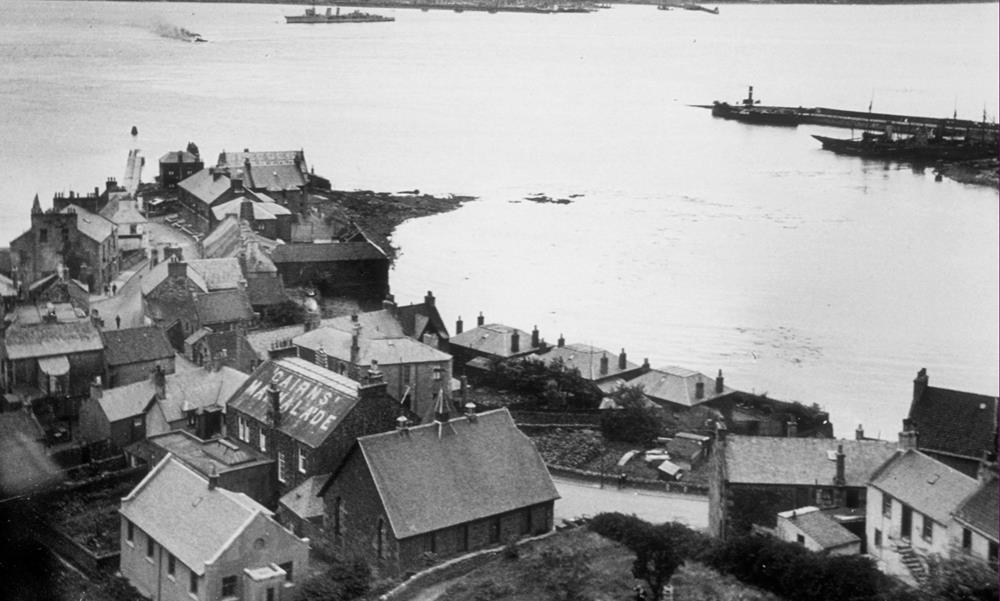
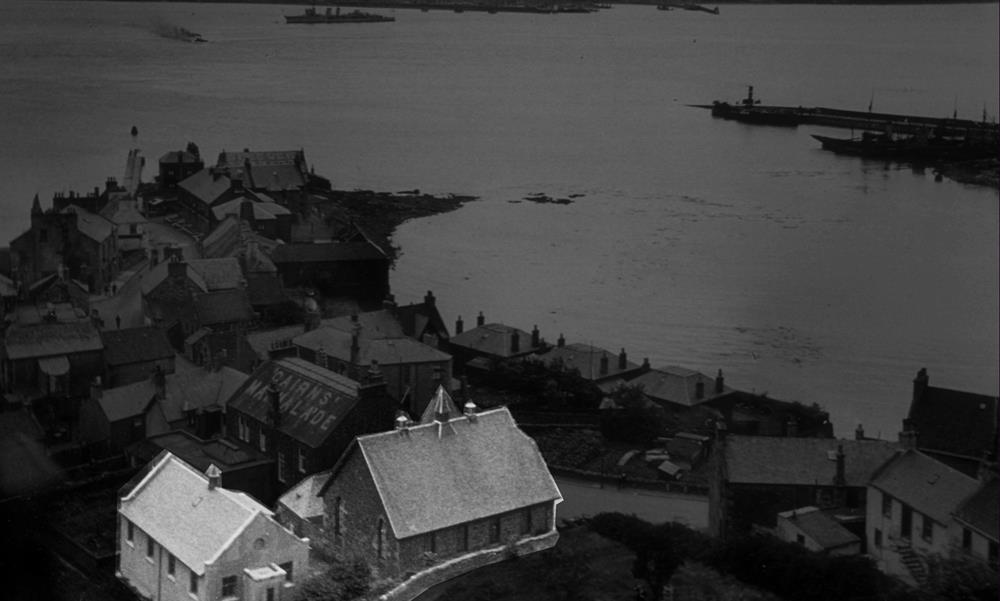
The church and its associated church hall are seen here at the bottom left of this photograph. (Highlighted for clarity in this thumbnail)
The hotel next door (the present Ferry Bridge) carries an advert for Cairns Marmalade.
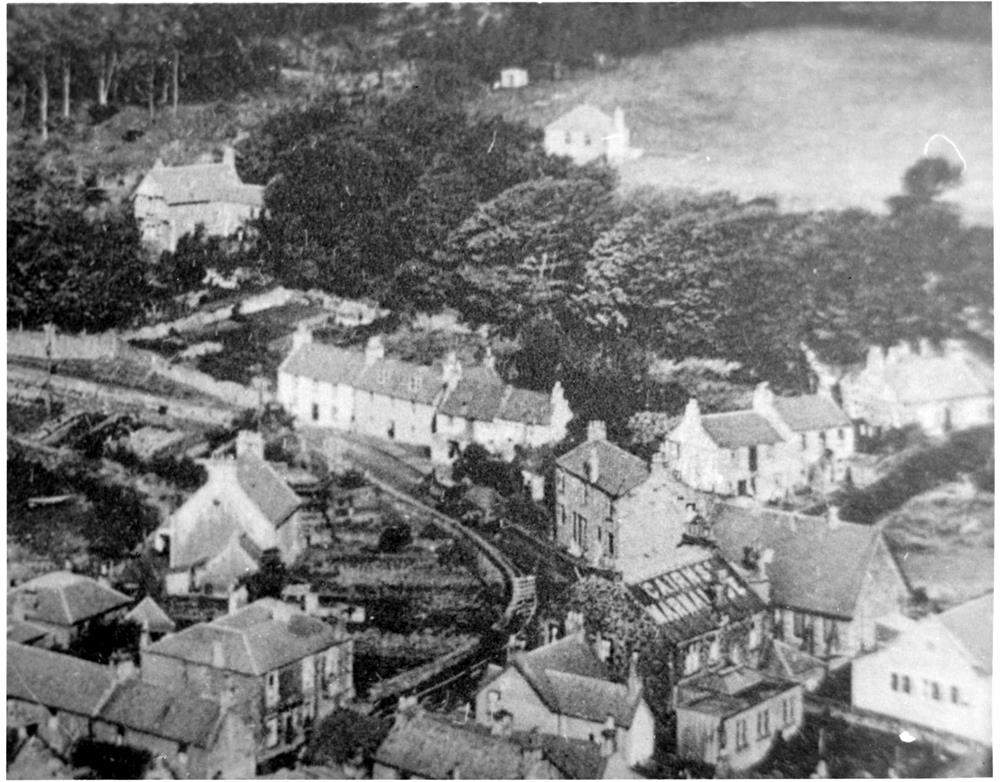
The church and its associated church hall are seen here at the bottom right of this photograph
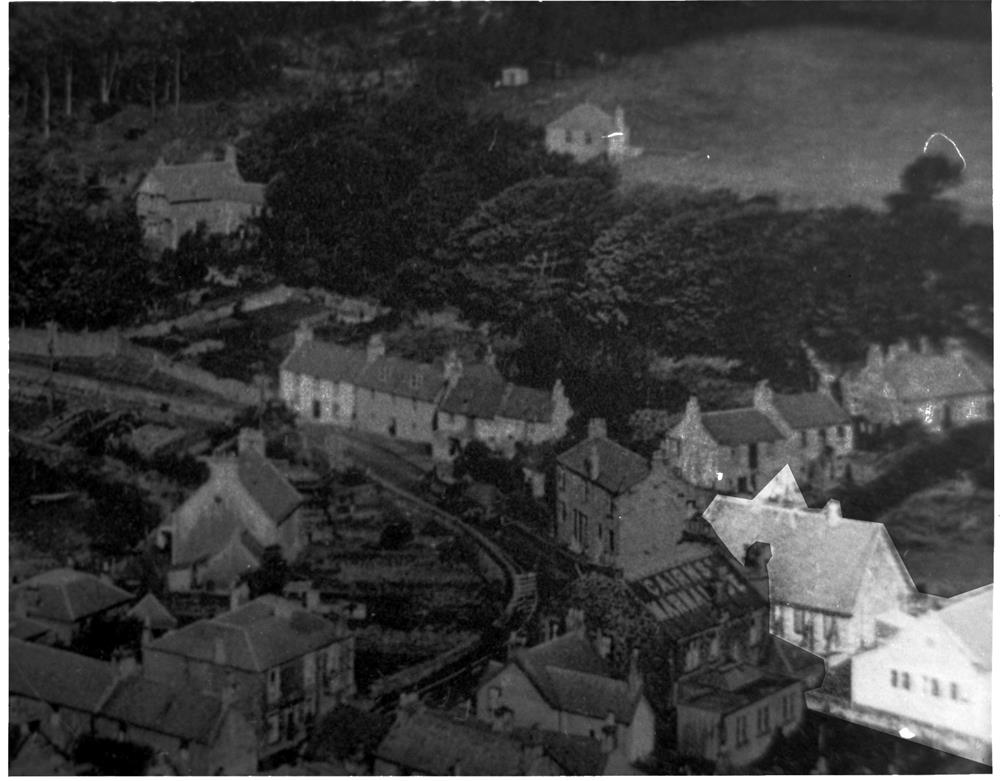
(Highlighted for clarity in this thumbnail)
The War Memorial was erected in 1921, and originally stood outside the old church.
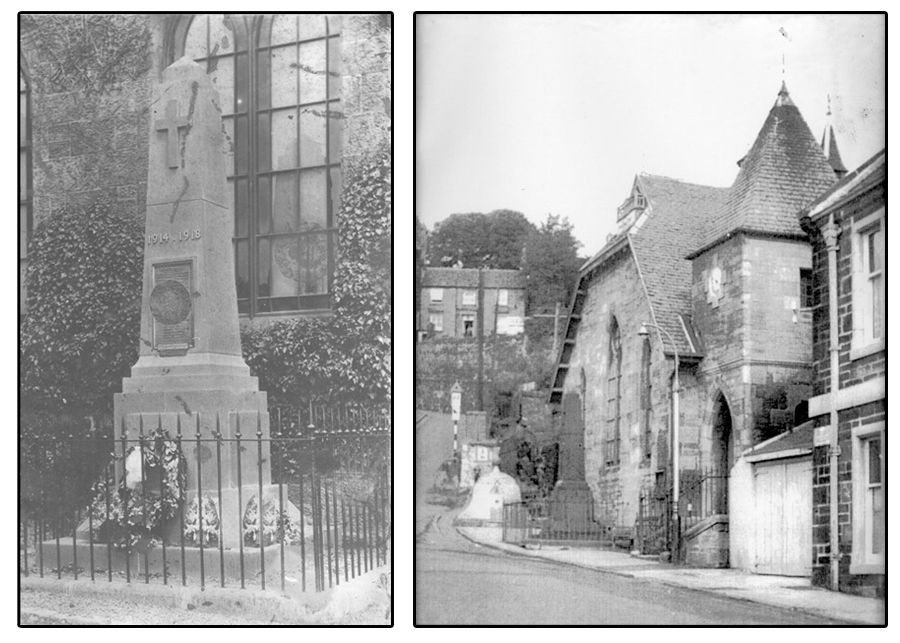
top of page
1926 – The Ypres Bell
On Sunday 23rd May, the Rev. Mr. Bain officiated at the dedication ceremony at North Queensferry Free Church of an “Ypres Bell,” a gift from the Session Clerk, Peter Anderson. The bell was in memory of those who fell in the war.
A wall plaque commemorates the occasion. The bell itself carries the cast inscription:
The “Ypres Bell” War Memorial 1914-18.
Erected 1926
By Peter Anderson Session Clerk.
It is not known if the “Ypres Bell” replaced the belfry bell presented by Mr Wilson in 1878, or if it hung somewhere inside the church.
20th century changes
The church passed successively to the United Free Church (in 1900) and the Church of Scotland (in 1929), but was reduced in status in 1939 and is said to have been worked thereafter by probationers until 1951. The Church of Scotland charge was linked with Inverkeithing St John’s in 1958 and became linked with Inverkeithing on the union of St John’s and St Peter’s on 5th November 2006. It was formerly in the presbytery of Dunfermline and Kinross before this became Dunfermline and was in the synod of Fife until the abolition of synods in 1993
top of page
Ministers in the “new” church
1878 – Rev. Shiach instituted services
Kirk Session minute book prior to 1926 is apparently in the hands of the National Archives of Scotland CH3/1294 and requires research to identify personnel prior to 1926
1926 – Rev. A.W. Bain inducted to North Queensferry United Free Church. He led the Congregation into the Church of Scotland in 1929 and died 19 May 1929
1929 – Rev. J. Miller Graham inducted 12 September. He retired 31 Mar 1939
1940 – Rev. Wm. A. Simpson (Assistant-in-charge under Dunfermline Abbey) appointed Mar 1940
1944 – Rev Daniel E. Gunn (Assistant-in-charge under Dunfermline Abbey) app.19 Feb 1943, he had left by Dec 1944
1951 – Rev. Harry J. Marr inducted 18 July, retired 15 March 1955
1955 – Rev. James L. McLeod inducted December 1955. Left at Jul 1958 on Linkage with Inverkeithing St John’s
1958 – Rev. D. C. Moir (St John’s) from July 1958, until March 1962
top of page
Session Clerks in the “new” church
1926 – Peter Anderson
1938 – W.J. Mathewson appointed 25th December 1938
1939 – Rev. Simpson served as Clerk from October 1939 for Rev. Robert Dollar, Interim Moderator
1962 – Demolition of the “new” church
A scant eighty-four years after the “new” church was opened in 1878, the building had degraded, and was deemed to be beyond economic repair.
In Mar 1962 it was proposed to authorise the demolition of the old Church; services were held in the School meantime. The problem is said to have involved the roof, but there are apparent references to boiler trouble, damage by blasting during work on the new road bridge and possibly woodworm as well. On 27 June 1962 the Deacons Court notes that the National Church Extension Committee had now assumed full responsibility for the building project for a new Church and hall. On 27 Aug 1962 it was agreed to put “the old site” up for sale. The site was purchased by Fife Council in order to construct what is now Old Kirk Road and thus provide better access to the east side of the village.
The War Memorial was moved to its present location on Main Street in 1963.
top of page
1963 – The Present Church
The present Church was dedicated by Rev Douglas Beck just prior to the induction of Harold Troup, which took place on 27 March 1963.
On 13 Mar 1964 the AGM was held “in the Church”.
The year 1964 saw the discontinuation of the ferry and on 6th September a service was held on board the Queen Margaret, in conjunction with South Queensferry and a band from HMS Caledonia.
At some point in 1964 the church also apparently hosted a “Radio Songs of Praise” jointly with South Queensferry and Inverkeithing, conducted by Rev A. D. Stirling.
In October 1965 Presbytery approved the building of the church hall; by January 1966 the sum of £1,015 had been raised in the village. The foundations were laid in May 1966 and the hall was dedicated by Mr Troup on 11 September 1966. By March 1968 the cost of the hall had been paid off.
The centenary was celebrated by a summer fete on Saturday 24 June 1978 in a marquee in the field at the back of the hall.
A booklet was published in celebration of one hundred years of North Queensferry Church – reproduced here.
top of page
Ministers in the present church
1963 – Rev. Harold Troup inducted 27th March 1963, left 25 October 1970
1971 – Rev. Alexander Strickland inducted 12th May 1971 (his first charge), he left for Arran 18th August 1976
1977 – Rev. William Baird inducted 25th August 1977, retired (?) after 14 March 1993
1995 – Rev Sheila Munro inducted some time between 12th May and 28th August 1995, joined RAF as Chaplain 30th January 2003
2005 – Rev. Christopher Park inducted 13th January 2005, retired on health grounds 17th October 2010
2012 – Rev. Colin Alston, inducted 13th September 2012
Session Clerks in the present church
1942 – David Laidlaw appointed 8th July 1942 died February (?) 1969
1968 – J. Finley (?) acting (?) October 1968
1969 – Wm Marshall Lamont appointed February 1969 retired Jun 1981
1981 – T. Roberts appointed 10th September 1981 retired 13 Feb 1990
1990 – Helen Leitch appointed. 29th March 1990 retired 25 Oct 2012
2012 – Colin Bain appointed 25th October 2012
top of page
The interior of the present church. . .
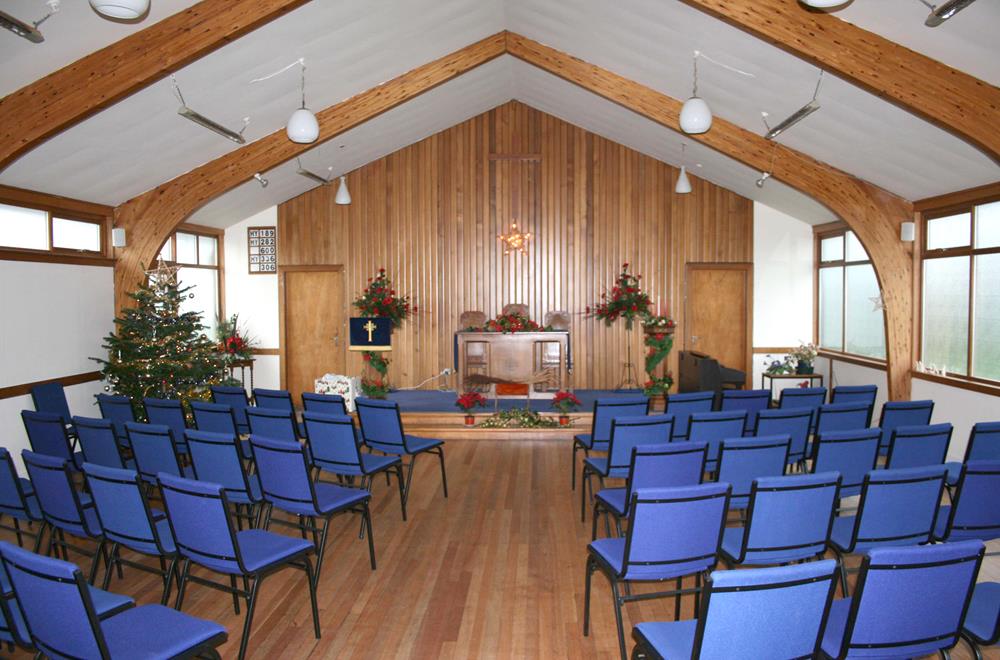
. . . dressed for Harvest Festival in 2012
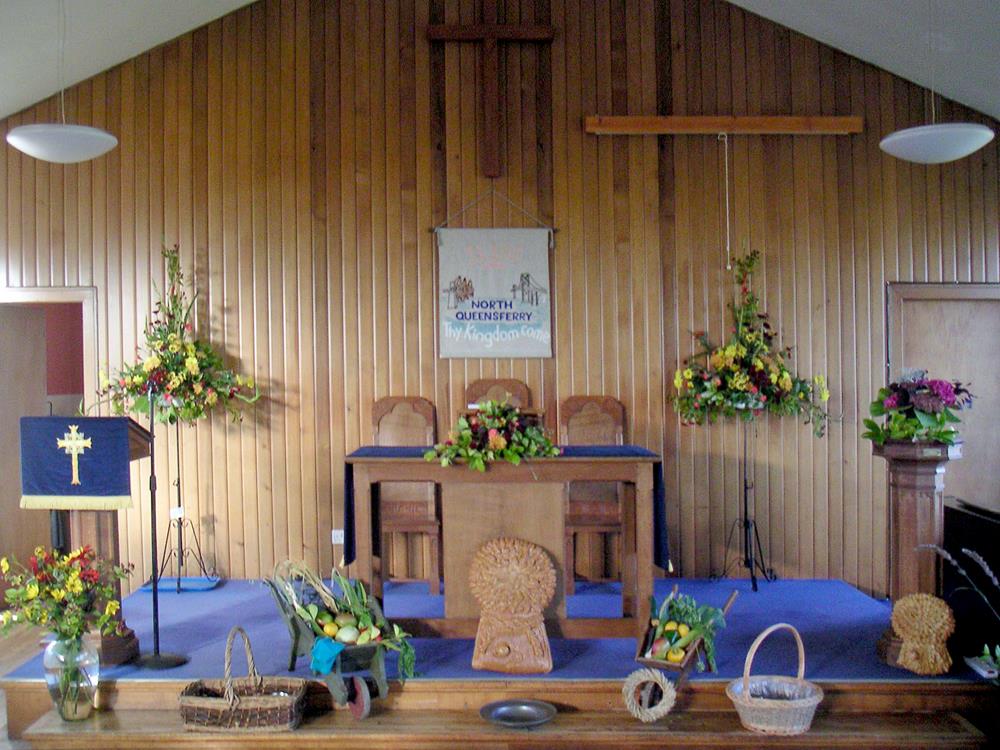
The new banner from 2013
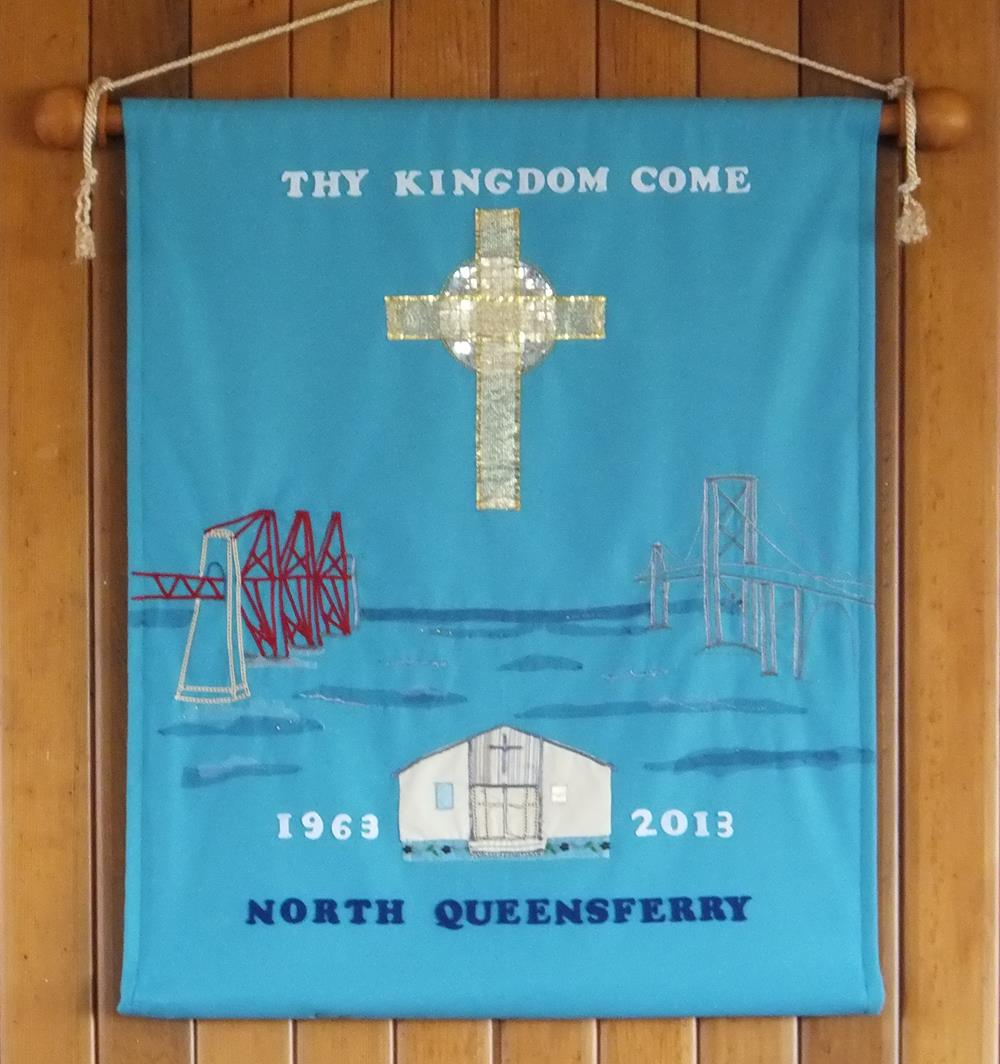
The “Ypres Bell” was brought from the old church, and now hangs outside the present church.
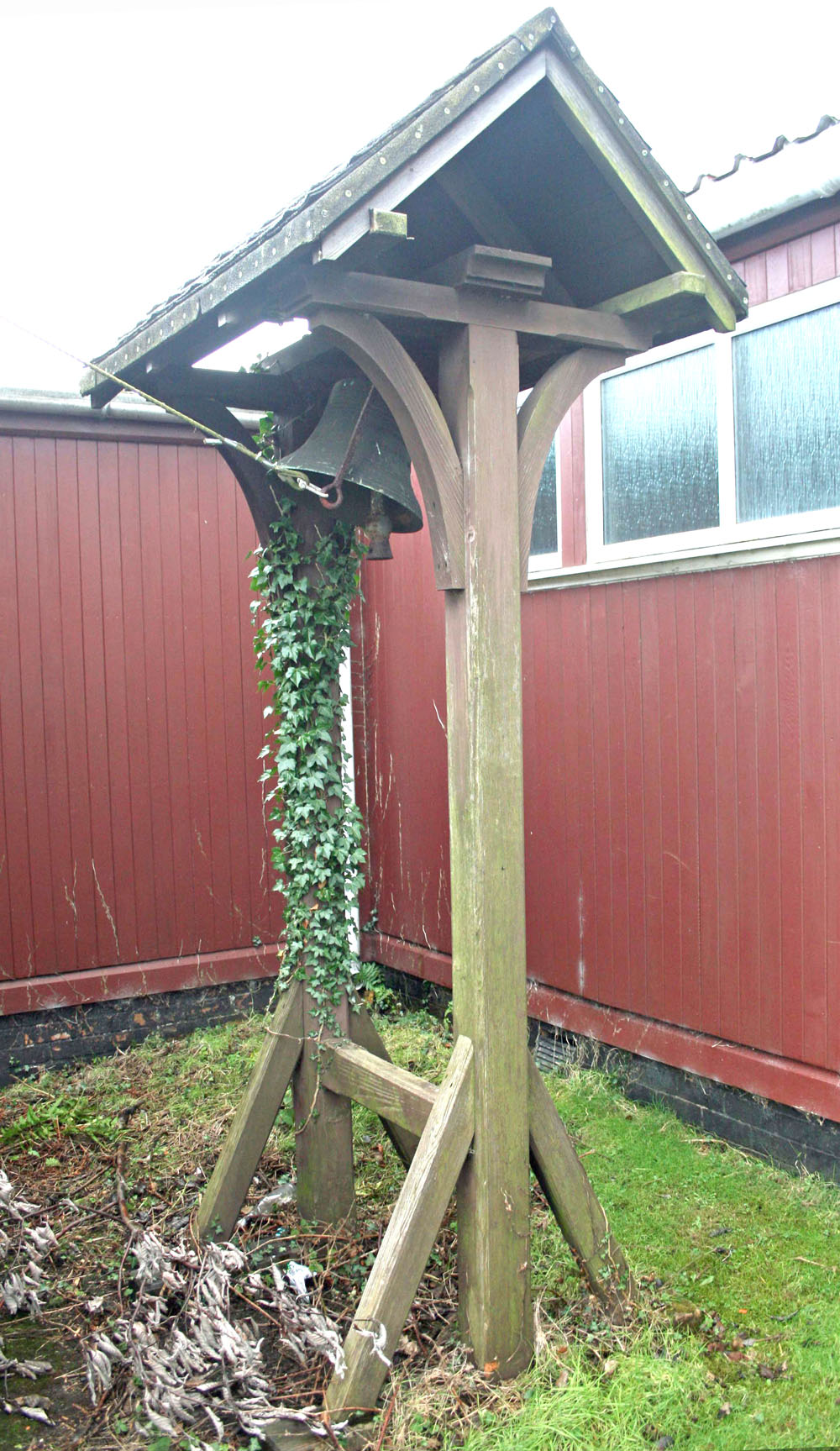
We have been unable to find any other references to an “Ypres Bell” War memorial, beyond this brief local newspaper article.
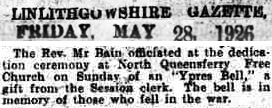
The bell was possibly inspired by an Imperial (now Commonwealth) War Graves Commission project to create a Chapel of Remembrance in Ypres to complement the Menin Gate war memorial.
St George’s church was designed in 1926 by Sir Reginald Blomfield, who also designed the Menin Gate Memorial. The tower at the church, which opened in March 1929, was originally intended to house a peal of English change ringing bells, but funds ran out. Following a fund-raising campaign in 2017, a set of eight bells were cast by John Taylor & Co in Loughborough. The bells carry individual inscriptions, following the pattern of commemoration found throughout the church. The bells were blessed and installed in the church in October 2017.
St George’s Church Ypres – History
St George’s Church Bells – BBC report
top of page
December 2017 update
Thanks to some sterling detective work from George Dawson and Chris Pickford, archivists at the Loughborough Bell Foundry, we have tracked down the origin of the North Queensferry “Ypres Bell.” It was cast by Mears & Stainbank, Whitechapel, London.
Here is the entry from the foundry daybook for 31 March 1926.
Sadly the Whitechapel Bell Foundry closed in December 2016. It was Britain’s oldest manufacturing firm.
The Whitechapel Bell Foundry; a curfew tolls…
The bell cost £18 5s 0d; the inscription added £1 13s 0d and carriage to Edinburgh was 13/6d
Total cost of £20 11s 6d.
This is the equivalent of £1150 in 2017.
It was delivered via Alder and Mackay Ltd., New Grange Works, Stewart Terrace, Edinburgh.
Alder and Mackay were manufacturers of pre-paid gas meters.
Acknowledgements
Material on the Chapel of St James, and early life in the village is drawn from Peter and Carol Dean’s “Passage of Time” and Pat Dennison’s “Historic North Queensferry and Peninsula.”
Colin Bain provided material on the old church and present church, including the 1978 newsletter.
Boyd Williamson provided the late 19th century material from Dunfermline Press.
top of page
top of page


















